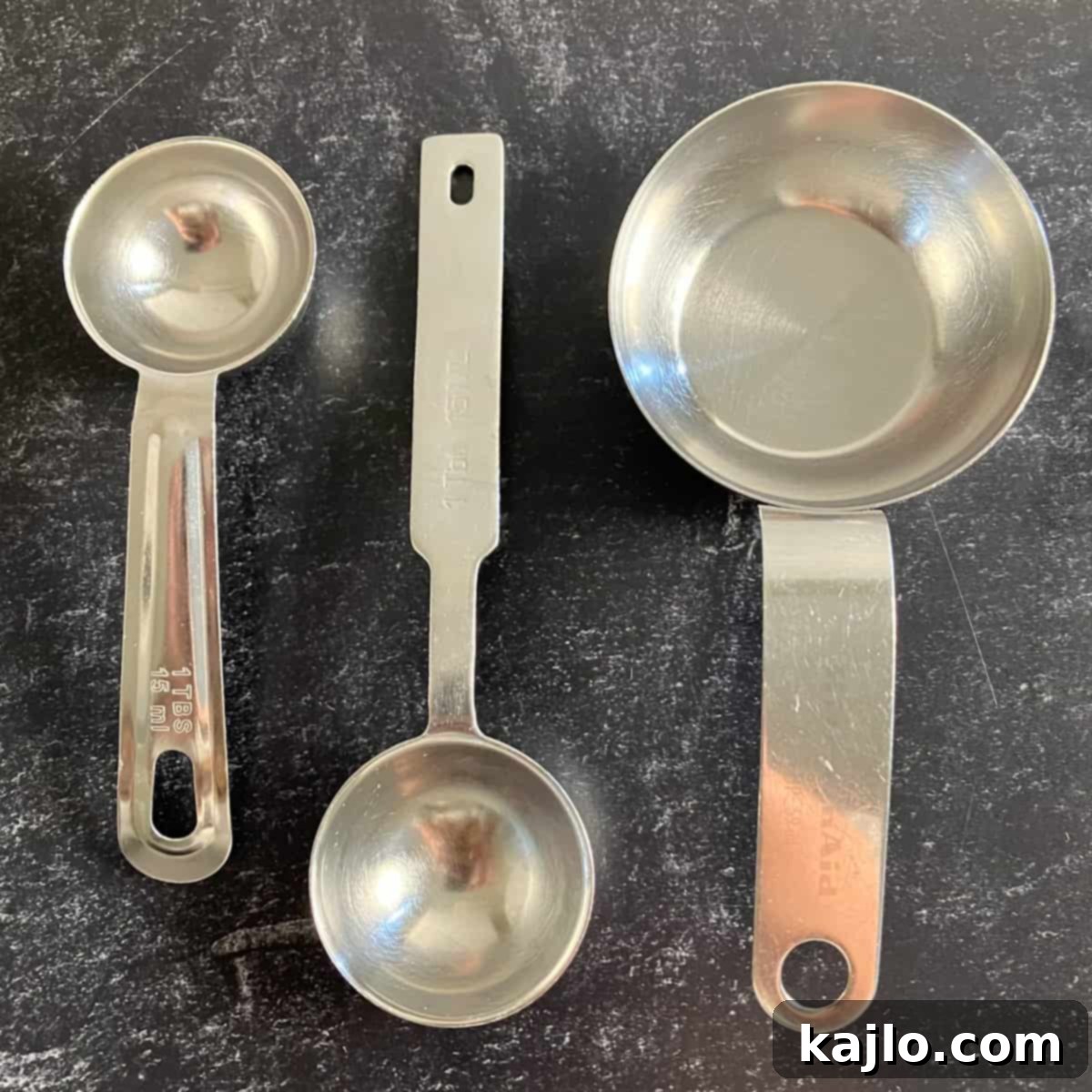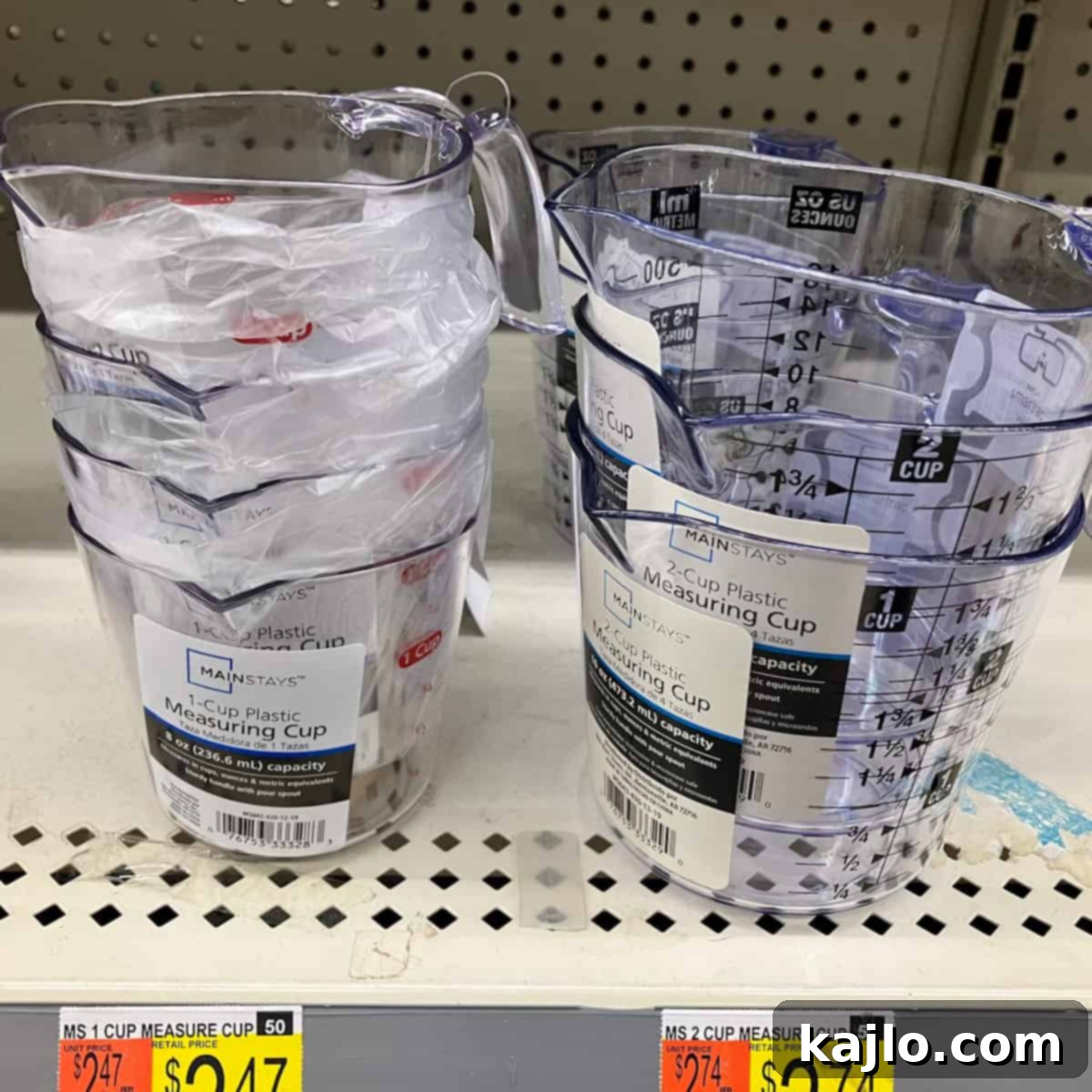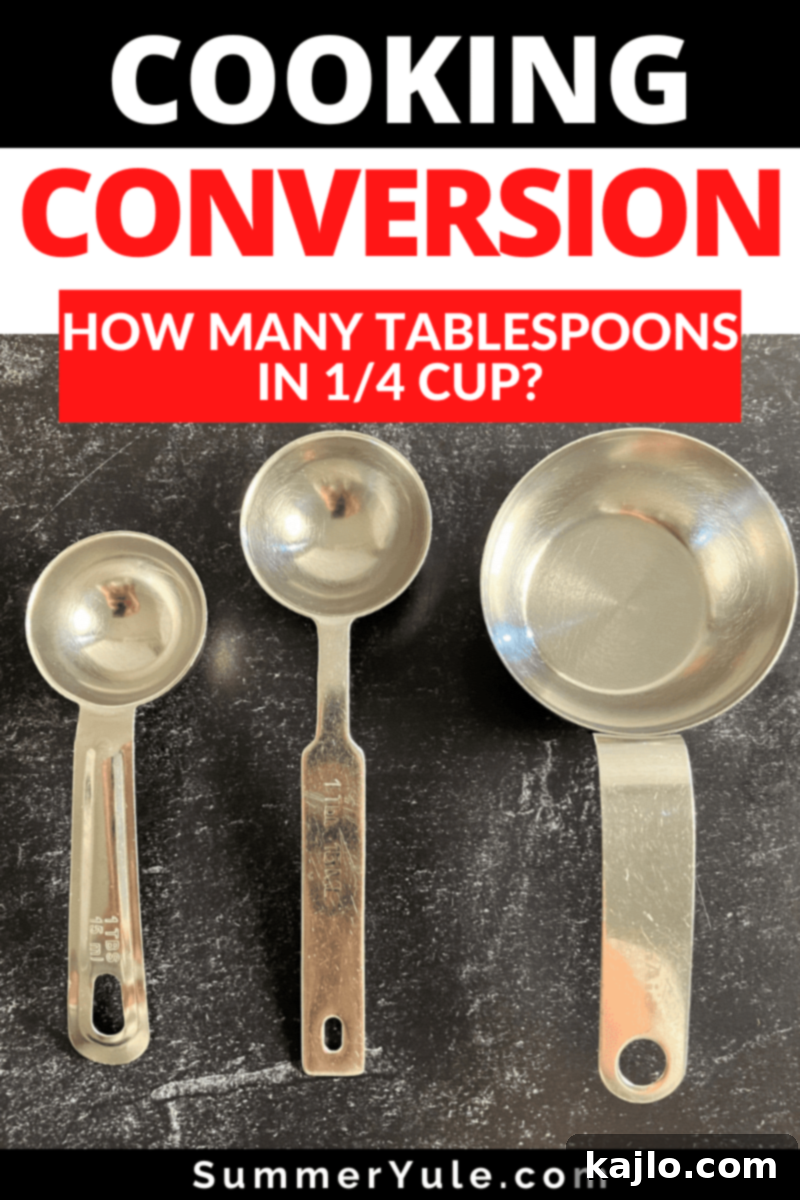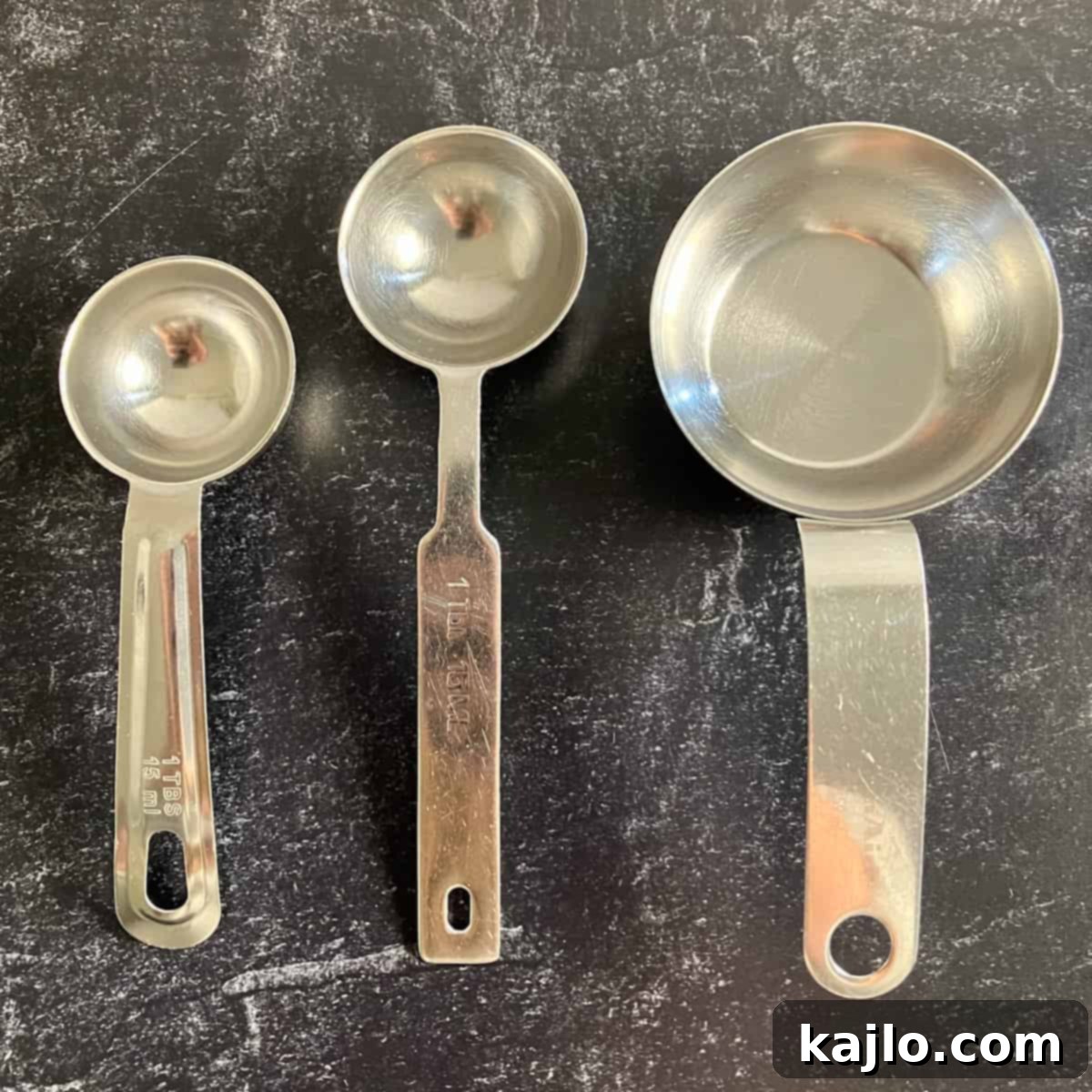Unlock Perfect Recipes: How Many Tablespoons in 1/4 Cup?
Ever found yourself staring at a recipe, only to realize you’re missing a specific measuring cup? Or perhaps you’re converting an international recipe and need precise imperial or metric values? One of the most common kitchen conundrums revolves around converting cups to tablespoons, especially for smaller measurements.
Let’s cut straight to the chase: one quarter cup (¼ cup) equals 4 tablespoons (4 Tbsp) in the standard US customary system. This essential conversion applies equally to both dry ingredients and liquid ingredients, simplifying your cooking and baking adventures.

Understanding this fundamental kitchen conversion is a game-changer. It empowers you to accurately measure ingredients even when you don’t have a ¼ cup on hand, allowing you to confidently tackle any recipe. Whether you’re a seasoned chef or a beginner baker, mastering these basic unit conversions is key to consistent and delicious results.
The Core Conversion: ¼ Cup to Tablespoons Explained
At the heart of US customary kitchen measurements lies a simple relationship: 1 cup is equivalent to 16 tablespoons. From this foundational fact, we can easily derive how many tablespoons make up a quarter cup.
1 cup = 16 tablespoons
To determine the number of tablespoons in ¼ cup, we simply multiply the fraction of a cup by the total number of tablespoons in a full cup:
(Number of cups) × 16 = Number of tablespoons
Applying this formula to our specific question:
(¼ cup) × 16 = Number of tablespoons
¼ × 16 = 4 tablespoons
Thus, the answer is unequivocally clear: there are exactly four tablespoons in one-fourth of a cup when using the US customary measurement system. This straightforward calculation makes it incredibly simple to adjust recipes or use alternative measuring tools.
Navigating Global Kitchens: International Measurement Differences
While 1/4 cup equals 4 tablespoons in the United States, it’s crucial to understand that measurement standards can vary significantly across the globe. When asking “how many tablespoons in a quarter cup,” the answer depends heavily on your geographical location and the specific measurement system being used in the recipe.
The US customary system, prevalent in American home baking and cooking, differs from other systems. For instance, the US legal cup is primarily used for nutritional labeling, differing slightly from the customary cup. Beyond the US, you’ll encounter metric, imperial, and Australian systems, each with its own tablespoon definition.
The UK metric cup, commonly used in Canada, New Zealand, and the UK, is quite similar to the US cup, often allowing for interchangeable use in many recipes without significant issues. However, older British and Commonwealth recipes might refer to the imperial system, which has distinct conversions.
Australia introduces another layer of complexity, where a tablespoon typically contains 20 milliliters, and 4 Australian teaspoons make up one Australian tablespoon. This contrasts with the US tablespoon, which is generally 15 ml, and comprises 3 teaspoons. Such differences can indeed make converting international recipes a little tricky for Australian cooks!
To help you navigate these global variations, here’s a comprehensive conversion table for a quarter cup across different systems:
| Cups | US Tablespoons (Tbsp) | Metric Tablespoons (UK) | Imperial Tablespoons | Australian Tablespoons | Milliliters (mL) |
|---|---|---|---|---|---|
| ¼ US Customary Cup | 4 | 3.943 | 3.331 | 2.957 | 59.147 |
| ¼ US Legal Cup | 4.058 | 4 | 3.379 | 3 | 60 |
| ¼ Imperial Cup | 4.804 | 4.736 | 4 | 3.552 | 71.033 |
| ¼ Metric Cup (UK, International) | 4.227 | 4.399 | 3.52 | 3.125 | 62.5 |
Always double-check the origin of your recipe to ensure you’re using the correct measurement system. A slight difference in tablespoon volume can sometimes impact the final outcome, especially in delicate baking.
Essential Conversion Charts for Your Kitchen
Beyond the specific ¼ cup conversion, having a broader understanding of tablespoon-to-cup ratios can streamline your cooking process. This comprehensive chart focuses on US customary measurements, providing conversions not just between tablespoons and cups, but also including teaspoons and fluid ounces for a complete picture.
| Tablespoons (Tbsp) | Cups (c) dry or liquid ingredients | Teaspoons (tsp) dry or liquid ingredients | US Fluid Ounces (fl oz) liquid ingredients |
|---|---|---|---|
| 1 | 1/16 | 3 | 0.5 |
| 2 | 1/8 | 6 | 1 |
| 3 | 3/16 | 9 | 1.5 |
| 4 | 1/4 | 12 | 2 |
| 5 | 5/16 | 15 | 2.5 |
| 6 | 3/8 | 18 | 3 |
| 7 | 7/16 | 21 | 3.5 |
| 8 | 1/2 | 24 | 4 |
| 9 | 9/16 | 27 | 4.5 |
| 10 | 5/8 | 30 | 5 |
| 11 | 11/16 | 33 | 5.5 |
| 12 | 3/4 | 36 | 6 |
| 13 | 13/16 | 39 | 6.5 |
| 14 | 7/8 | 42 | 7 |
| 15 | 15/16 | 45 | 7.5 |
| 16 | 1 | 48 | 8 |
It’s important to remember that these are all volume measurements. While liquid ingredients are relatively consistent by volume, dry ingredients can vary significantly in weight for the same volume. For example, 8 ounces (weight) of butter is approximately one cup, but 8 ounces (weight) of flour or dry macaroni pasta will occupy a different volume. This distinction highlights why weighing dry ingredients, especially in baking, often yields more consistent and accurate results than volume measurements.
Mastering Measurement Techniques for Perfect Results
Accurate measurements are the cornerstone of successful cooking and baking. Even with the correct conversions, improper measuring techniques can throw off your entire recipe. Here are some essential tips to ensure precision:
- Leveling Dry Ingredients: When measuring dry ingredients like flour, sugar, or cocoa powder, spoon the ingredient into your measuring cup or spoon until it overflows slightly. Then, use the flat side of a butter knife or a straight edge to level off the excess, ensuring an exact measure. Avoid packing down dry ingredients unless the recipe specifically calls for it (like brown sugar).
- Measuring Liquids Accurately: For liquids such as water, milk, or oil, use transparent liquid measuring cups. Place the cup on a flat surface and bend down to eye level to read the measurement at the bottom of the meniscus (the curve of the liquid). Overfilling or underfilling can significantly alter the recipe.
- The Power of the Food Scale: For ultimate accuracy, especially in baking, consider investing in a digital food scale. Weighing ingredients in grams or ounces eliminates inconsistencies caused by packing, humidity, or differences in ingredient density. Many professional bakers swear by weight measurements for their superior precision.
- Using the Right Tools: Always use dry measuring cups for dry ingredients and liquid measuring cups for liquids. Dry measuring cups are designed to be leveled off, while liquid measuring cups have a spout to prevent spills and markings that allow for accurate eye-level reading.
- Sifting Flour: If a recipe calls for sifted flour, sift it *before* measuring. Sifting aerates the flour, reducing its density, which can impact volume measurements.
By employing these techniques, you’ll minimize measurement errors and increase your chances of culinary success.
Quick Reference: Other Handy Measurement Conversions
While the focus is on ¼ cup, many other common conversions are equally useful in the kitchen. Here are answers to some frequently asked questions about converting tablespoons to cups and other units:
How many cups is 32 tablespoons?
Since 16 tablespoons equals 1 cup, 32 tablespoons would be 2 cups. This is also equivalent to one pint.
How many tablespoons in a full cup?
As established, there are 16 tablespoons in one standard US customary cup.
How many tablespoons in one gallon?
A gallon contains 16 cups. Therefore, 16 cups × 16 tablespoons/cup = 256 tablespoons in a gallon.
What is 16 tablespoons equal to in cups?
Sixteen tablespoons is precisely equal to one cup.
How many tablespoons in ¾ cup?
Following our formula (¾ × 16), there are 12 tablespoons in ¾ cup.
How many tablespoons in 2/3 cup?
Two-thirds of a cup equals approximately 10.67 tablespoons, often rounded to 10 tablespoons plus 2 teaspoons for practical kitchen use (2/3 × 16 = 10 2/3 tablespoons).
What is 10 tablespoons equal to in cups?
10 tablespoons is equal to 10/16 of a cup, which simplifies to 5/8 cup.
How many tablespoons in ½ cup?
Half a cup (½ cup) contains 8 tablespoons (½ × 16 = 8).
Does 7 tablespoons equal ¼ cup?
No, 7 tablespoons is not equal to ¼ cup. 7 tablespoons is 7/16 of a cup (0.4375 cup), while ¼ cup is 4 tablespoons.
How many cups is 6 tablespoons?
Six tablespoons is equal to 6/16 of a cup, which simplifies to 3/8 cup (or 0.375 cup).
How many tablespoons in 1/3 cup?
One-third of a cup (1/3 cup) equals approximately 5.33 tablespoons, commonly measured as 5 tablespoons plus 1 teaspoon (1/3 × 16 = 5 1/3 tablespoons).
What is 3 tablespoons equal to in cups?
Three tablespoons is 3/16 of a cup (or 0.1875 cup), not a third of a cup.
How many tablespoons in 1/8 cup?
One-eighth of a cup (1/8 cup) is equivalent to 2 tablespoons.
4 oz is how many tablespoons?
Four fluid ounces equals 8 tablespoons of liquid. Remember, this conversion is for fluid ounces, a volume measurement, not ounces of dry weight.
How many teaspoons in ¼ cup?
Since 1 tablespoon equals 3 teaspoons, and ¼ cup equals 4 tablespoons, one quarter cup contains 12 teaspoons (4 Tbsp × 3 tsp/Tbsp = 12 tsp).
How many tablespoons of ground coffee per cup?
While often varying by preference, many coffee makers recommend 1 tablespoon of ground coffee per 6 ounces of water. Since 6 fluid ounces is equivalent to ¾ US customary cup, this translates to about 1 1/3 tablespoons (or 1 tablespoon + 1 teaspoon) of ground coffee per standard 8-ounce cup of water, for a strong brew.
Common Ingredient Conversions: How Many Tablespoons in 1/4 Cup of…?
The 4 tablespoons = ¼ cup rule is remarkably consistent for most ingredients when measuring by volume. Here are some specific examples for common kitchen staples:
How many tablespoons in ¼ cup butter?
There are 4 tablespoons in ¼ cup butter. This conveniently equals half of a standard stick of butter, or 1/8 of a typical one-pound package (which usually contains four sticks).
How many tablespoons in ¼ cup cocoa powder?
¼ cup cocoa powder equals 4 dry tablespoons. Make sure to level it off carefully!
How many tablespoons in ¼ cup flour?
¼ cup flour equals 4 tablespoons. This holds true for various types of flour, including all-purpose flour, whole wheat flour, and gluten-free flour blends.
How many tablespoons in ¼ cup sugar?
For granulated sugar, ¼ cup also equals 4 tablespoons. The same applies to powdered sugar (confectioners’ sugar) and brown sugar (packed).
How many tablespoons in ¼ cup of oil?
Olive oil, vegetable oil, and other liquid oils measure 4 tablespoons per ¼ cup.
How many tablespoons in ¼ cup milk?
There are four tablespoons in ¼ cup of milk, whether it’s dairy milk or a plant-based alternative.
How many tablespoons in ¼ cup water?
Indeed, there are 4 tablespoons in ¼ cup of water. It seems a pattern has emerged!
How many tablespoons in ¼ cup shredded cheese?
Generally, there are 4 tablespoons in ¼ cup of shredded cheese. However, for accuracy, especially with larger or irregularly shaped shreds, it is highly recommended to measure cheese by weight using a food scale.
How many tablespoons in ¼ cup mayonnaise?
¼ cup of mayonnaise equals 4 tablespoons.
How many tablespoons in 1/4 cup cornstarch?
Four tablespoons equals one-fourth cup of cornstarch.
How many tablespoons in ¼ cup tomato paste?
There are 4 tablespoons in one quarter cup of tomato paste.
How many tablespoons in ¼ cup honey?
As you might have guessed by now, there are 4 tablespoons in ¼ cup of honey. When measuring sticky liquids like honey, coating your measuring spoon or cup with a little oil or cooking spray can help the ingredient slide out easily.

FAQs About Kitchen Conversions
Why are there different cup sizes internationally?
Different countries and historical periods developed their own systems of measurement based on practical needs and available tools. The US customary system evolved from British imperial units, but diverged before the UK fully adopted the metric system. These historical differences led to various definitions for a “cup” or “tablespoon” in different regions, necessitating careful conversions when using international recipes.
Is there a difference between “dry” and “liquid” tablespoons?
In terms of volume, a tablespoon is a tablespoon, whether it’s for dry or liquid ingredients. However, the *method* of measuring differs. Dry ingredients should be leveled, while liquid ingredients are read at eye level. Using the appropriate measuring tool (dry measuring cups/spoons for dry, liquid measuring cups for liquids) also aids in accuracy, as dry measuring cups are designed for leveling, and liquid cups for pouring and reading the meniscus.
Can I use a regular spoon instead of a measuring spoon?
While convenient in a pinch, a regular eating spoon is not an accurate substitute for a measuring tablespoon. The capacity of dinner spoons can vary significantly, leading to inconsistent results in recipes. For precise cooking and baking, always use standardized measuring spoons.
What’s the best way to remember conversions?
The most crucial conversion to remember is that 1 cup equals 16 tablespoons. From there, you can easily calculate fractions (e.g., 1/2 cup = 8 Tbsp, 1/4 cup = 4 Tbsp). Keeping a conversion chart handy in your kitchen or bookmarking a reliable online resource like this article can also be incredibly helpful.
Final Thoughts: Cook with Confidence
Understanding how many tablespoons are in ¼ cup, and mastering other essential kitchen conversions, removes a significant barrier to successful cooking and baking. With this knowledge, you can confidently scale recipes, adapt to different measuring tools, and perfectly execute dishes from around the world. Embrace the precision, and let your culinary creativity flourish!
More Helpful Kitchen Resources
Continue to build your kitchen knowledge with these other useful guides:
- 8 Ounces to Cups Conversion
- How Much is 3oz Chicken
Join our community! Subscribe for all of the latest and greatest recipes, and follow us on Facebook, Pinterest, Instagram, and YouTube!
Save This Guide for Later!

